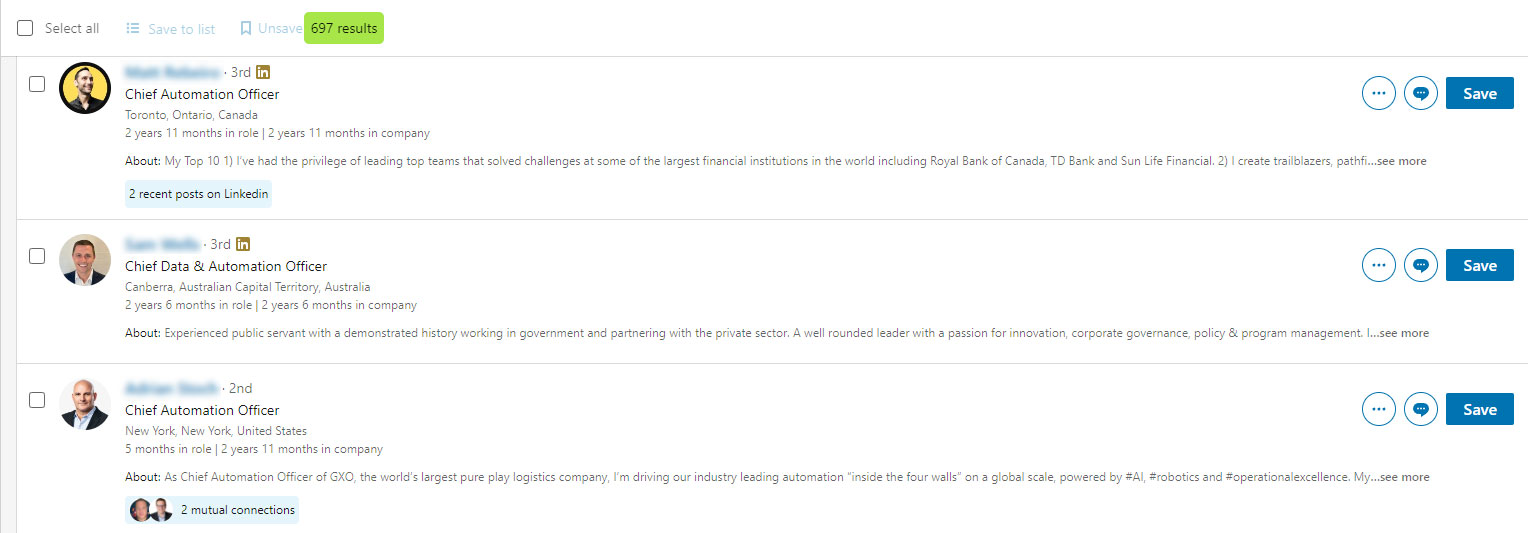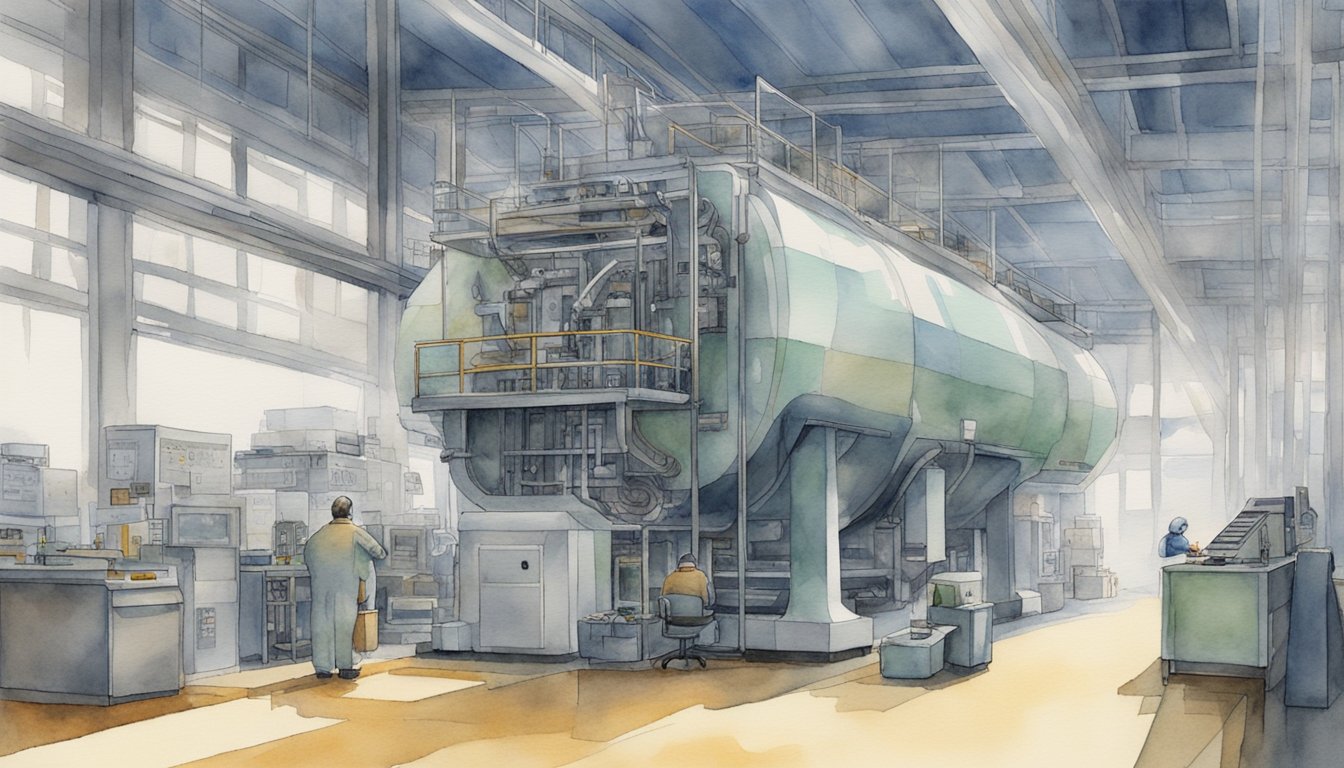I joke with people that I went to school to figure out what I didn’t want to do for the rest of my life.
It’s not that I don’t like industrial design; in fact, I think it’s one of the few professions where someone has the chance to skillfully blend art and science, emotion and engineering, to produce something beautiful and functional. But Chief Automation Officer?
The title didn’t even exist when I was in college.
Today, there are 679 results for “Chief Automation Officer” on LinkedIn.

I mostly decided to move my industrial design skills elsewhere because I didn’t want to spend my life drawing 150 versions of the same shoe or table each day.
The part I love about the profession, though, is the opportunity to envision an end product and determine all of the steps that need to take place in order to manufacture a physical product.
Make your plan. Plan your work. Work your plan.
Start with the end in mind. Map out the steps to get there. Carefully coordinate the steps until it is predictable and repeatable.
As someone who has been monitoring the ever-evolving business landscape over the past decade, one trend has made my heart happy: the rise of the Chief Automation Officer (CAO).
With the increasing importance of automation in today’s digital age, companies are creating a C-suite position dedicated to overseeing Robotic Process Automation (RPA) and other automation-related initiatives.

What is a Chief Automation Officer?
A Chief Automation Officer serves as the go-to executive for all things automation.
They’re in charge of defining the scope of pilot automation projects, implementing the right technology stack, and leading development teams on their quest to streamline processes and make businesses more efficient. All in all, this person aims to build pathways that support not only business processes but also IT infrastructure, integrations, and more.
Maybe it’s my formal training kicking in, but I believe automation starts with process.
It has to.
Without a clear vision of a company’s goals and how to get from A to B, automating the wrong things will only make things worse.
The role of a CAO doesn’t exist in isolation. In fact, they often work closely with other members of the C-suite like the Chief Information Office (CIO), the Chief Operating Officer (COO), and the Chief Data Officer (CDO). Together, we identify areas ripe for automation, collect data insights, and find innovative ways to apply automation strategically across the organization.
The emergence of the Chief Automation Officer position is a testament to the growing importance of automation and AI in the modern business world.
What is a Chief Automation Officer (CAO)?

The Chief Automation Officer (CAO) is growing in importance because the world that’s becoming more and more connected.
How so?
Current estimates suggest there are somewhere between 24,000 and 72,000 SaaS companies in existence right now. The average number of SaaS apps used by organizations is nearly 130.
The CAO is a relatively new addition to the C-suite, evolving with others like the CEO, CIO, CTO, Chief Digital Officer, and Chief Data Officer.
Does every company need a CAO? In the same way that every company doesn’t need a CMO or a CIO, the answer is “probably not.” But for those at a certain size or looking to scale well (see what I did there?), a CAO’s main responsibility is to implement business process automation and other technologies.
I make sure the automated processes are well-designed and efficient, and I am constantly on the lookout for opportunities to streamline operations.
Think of the CAO as the person responsible for making sure that every employee is performing their job as efficiently as possible and, ideally, without any hiccups.
Aside from focusing on automation, CAOs have a hand in making sure that company-wide efforts are well-coordinated and poised for success.
We build actionable dashboards that show how things are going in various departments instead of spending human resources on retrieving and then copy/pasting data. We help our clients spot any issues and opportunities at a glance. In this role, CAOs have a major impact on the corporation’s ability to stay competitive in an ever-changing digital landscape. Placed at the intersection of technology and business operations, the CAO ensures that automation strategies align with broader company goals, while also offering their expertise to help each department in the organization.
Roles and Responsibilities of a CAO

How Does a CAO Interact with the C-Suite?
As Chief Automation Officer (CAO), I typically work with the rest of the C-suite like the CEO, CIO, and COO, to ensure the successful implementation and management of automation, digital transformation efforts, and intelligent automation strategies.
My main goal is to enhance operational excellence across the organization. When it comes to communication, I help define and communicate key performance indicators (KPIs) and the impact of AI and automation on our business processes with other executives. By doing so, I help create a better understanding of the benefits and challenges associated with enterprise automation.
How Does a Chief Automation Officer Differ from a COO or CIO?
While the roles of a COO or CIO may overlap with that of a CAO, they have distinct differences.
CAOs oversee the company’s automation initiatives, particularly those that impact operational teams by working to integrate AI and automation technologies into our current systems and processes. On the other hand, a COO focuses on overseeing the day-to-day operations of the organization and ensuring that all departments work effectively together.
A CIO or CTO, meanwhile, is responsible for managing the company’s technology infrastructure and driving the digital products it sells to customers.
Some areas where my role as a CAO may differ from a COO or CIO include:
- Concentrating on implementing and managing automation technologies
- Developing project templates for automation initiatives
- Connecting software and existing systems, and using no-code tools and environments to do so
- Ensuring both productivity and work-life balance for employees improves through the optimization of business processes
- Overseeing the use of intelligent automation to support enterprise-wide digital transformation
Fractional Chief Automation Officers
For smaller organizations or those not quite ready to commit to hiring a full-time, dedicated CAO, hiring ScaleWell as a Fractional Chief Automation Officer might be the perfect solution.
In this capacity, we work with organizations part-time or on a project basis, providing expertise and guidance in the aforementioned roles and responsibilities.
We put our expertise and experience to work to help companies jump-start our client’s automation strategies and put them on a path to success without the need to invest heavily in a full-time executive. This approach allows businesses to adapt and invest in AI and automation initiatives at their own pace while still benefiting from our expertise and experience with the technology.
Why Are CAOs Becoming Popular?

The Rise of AI, RPA, and Automation Services
The rise of new technologies like artificial intelligence (AI) and robotic process automation (RPA) are transforming how businesses operate and accelerated the need for automation expertise at organizations large and small. But automation tools that connect existing SaaS have been around for nearly a decade and they are still highly underutilized, in my opinion.
I believe this because I’ve seen their impacts first-hand.
A Real-World Example
During my time as COO at my last company, we were in a trial period with a well-known, national media company. This was our big chance.
We had just launched a pilot program in two of the local markets they served. If our product resonated with their advertisers and if we could service the demand, we had a shot at rolling out nationally to dozens of markets.
The opportunity was large, but we were young.
And as a result, our processes were… non-existent.
Initially, our two young Account Managers traded emails with their sales teams to take client orders and collect campaign details. At the time, I remember running the numbers and thinking, “We’ll need to hire 20+ account managers to make this work nationally!”
So I set to work.
Over the course of a month or so, my team and I built a system that ingested ad campaign details, then systematically added the details to our Salesforce, Zendesk, Trello and email confirmation systems – all with little to no code.
The result? Three Account Managers now service hundreds of campaigns a month, generate around 8-figures of revenue a year, and support hundreds of sales reps across 25+ markets.
What is (still) most impressive to me is that the systems my team built:
- did not rely on our Engineering teams (they were mostly “no-code” solutions)
- ran for 7+ years. (only recently were they rebuilt from the ground up to more tightly integrate with our campaign management capabilities)
Similar technologies are making it possible to automate tasks and processes with the need for less and less human intervention. As a result, businesses looking to optimize their internal processes elevates the need for a Chief Automation Officer (CAO) who can oversee and strategize the use of these technologies for their benefits.
Business Optimization Strategies
My observation is that CAOs are becoming increasingly popular as they help in scaling businesses in hyper-growth environments. Many employees are becoming more technical, yes – but not everyone is a developer. And that is OK. My perspective is that engineers should be building the unique products that can be sold to end customers, while semi-technical teams (either internally or like those at ScaleWell) are building solutions that make the business run more efficiently.
By overseeing the implementation of business process automation (BPA) software, no-code platforms, and digital operations strategies, CAOs ensure that organizations can grow rapidly without compromising the quality of their products and services.
- BPA: They implement BPA to make operations more efficient and cost-effective.
- No-code platforms: CAOs help businesses adopt no-code platforms which enable non-technical users to develop applications quickly.
- Digital operations strategies: Digital operations focus on streamlining technology and internal processes to improve overall business performance.
Outsourcing Automation Responsibilities
Finally, I’ve noticed that hiring a CAO allows businesses to outsource some of the responsibilities related to process automation.
As an expert in this field, a CAO knows which workflow, AI, and RPA technologies best fit the organization’s needs and can effectively scale their implementation. This distributes the responsibility of managing automation projects and frees up other executives to focus on core business functions while ensuring that processes – either automated or performed by employees – continue to support a company’s growth.
The Importance of Process and Automation on Businesses

As a business owner, I’ve come to realize how crucial process optimization and automation are for the success of a company. The long-term goal of every organization is to produce free cash flow. Since the largest expense in a company’s OpEx is often people, one of the best ways to do drive that number down is to get more done with fewer people.
Simplify. Simplify. Simplify. Then, automate.
It is important to first understand and build efficient processes, before using technology to streamline operations and improve overall efficiency.
Impact on Workforce
In my experience, incorporating workflow tools, bots, and a digital workforce can lead to significant changes in the way employees work. When I started implementing automation, I noticed that it freed up employees’ time by taking over repetitive and mundane tasks. As a result, they were able to focus on more creative and strategic projects, which ultimately improved their job satisfaction and overall motivation.
- Tasks automation: Reduces manual work and encourages employee engagement in higher-value activities
- Skill development: Employees can focus on learning new skills and enhancing their existing ones
- Improved efficiency: A digital workforce can work around the clock, leading to increased productivity
Technology has long improved the quality and productivity of our work, but the greatest benefit occurs when it is used by skilled operators.
Impact on Business Operations
Automation has not only transformed our workforce, but it has also had a significant impact on overall business operations. By integrating technology strategies with RPA and AI, I’ve noticed the following changes in my company’s operations:
- Process optimization: Automated processes help to reduce errors, ensuring tasks are completed accurately and efficiently
- Cost savings: Reduced labor costs and minimized operational expenses
- Scalability: Automation allows me to quickly adapt to fluctuations in demand and workload
- Data-driven decision making: Enhanced data management and analysis generate valuable insights for effective decision making
Overall, embracing automation has led to a variety of benefits for both our workforce and business operations. I’ve found that by first focusing on streamlining processes, I can then implement automation solutions that have a meaningful impact on our efficiency and success.
Future Trends in CAO’s Role

As a Chief Automation Officer (CAO), I see a lot of exciting developments on the horizon that will shape the role in the future.
With the rapid advancements in fields like machine learning, natural language processing (NLP), voice-to-text, image-to-text, and more, there’s no doubt that the CAO’s role will keep evolving to leverage these cutting-edge tools.
In the world of machine learning, NLP is taking center stage. It is opening up incredible opportunities for automating tasks that require understanding and generating human-like responses. Personally, I can’t wait to see how we’ll use these technologies to further streamline communication and collaboration within businesses and for their customers. And as we continue to adopt innovative solutions, I believe we’ll find ourselves closer to the top of the innovation adoption curve.
As a CAO, I’m also keeping my eye on data interpretation and visualization tools. When it comes to formatting and conveying information, we are always looking for ways to make it easier to read and understand data from a company’s business operations. Tables, bullet points, and bold texts have been in use for years, but sophisticated charts using real-time data now give business owners the insights they need to make decisions quickly.
Lastly, as a leader in automation, ScaleWell stays up-to-date on the latest trends and tools, ensuring that we are on forefront of innovation and can pass those learnings down to our clients.
Frequently Asked Questions

What are the key responsibilities of a CAO?
As a Chief Automation Officer (CAO), my main responsibility is to oversee enterprise automation, ensuring it supports business processes, IT infrastructure, integrations, and more. I develop strategic plans, manage pilot automation projects, and implement appropriate technologies to streamline operations in an organization.
How does a Chief Automation Officer impact business strategy?
As a CAO, I make a significant impact on business strategies by integrating automation technologies like workflow software, AI, and automation tools into everyday operations. My efforts in automating repetitive tasks and improving efficiency across departments help organizations become more agile and competitive in the market.
What skills are essential for a CAO?
For a CAO to be successful, a deep understanding of process (inputs, sequencing, etc.) and strong semi-technical knowledge in automation technologies is essential. Excellent communication, leadership, and problem-solving, and project management skills to effectively collaborate with various departments and drive enterprise-wide automation initiatives are a must.
How do CAOs collaborate with other C-level executives?
As a CAO, I work closely with other C-level executives, including the CEO, CTO, and CIO, to ensure that our automation strategy aligns with the organization’s overall goals. I communicate calculate the potential ROI, benefits, progress, and challenges of automation projects, and collaborate on defining the scope and roadmap for future initiatives.
In which industries are CAOs typically employed?
CAOs can be found in various industries, including manufacturing, finance, healthcare, retail, and IT services. Businesses in these industries often adopt automation technologies to improve efficiency, reduce costs, and gain a competitive advantage.
What is the career path to becoming a Chief Automation Officer?
My untraditional journey to becoming a CAO started with a degree in industrial design. It then shifted to learning online marketing, applying my process training to digital workflows, transitioned to leading operational teams as COO, and is now focused on continually adding more technical skills to apply to automation tools. Typically, CAOs start with a strong background in technology and business strategy. Prior experience in IT management, data analysis, or automation project leadership are common stepping stones. Some CAOs may also hold advanced degrees in engineering, computer science, or business administration, which provide a strong foundation in understanding the complexities of integrating automation into an organization’s operations.

